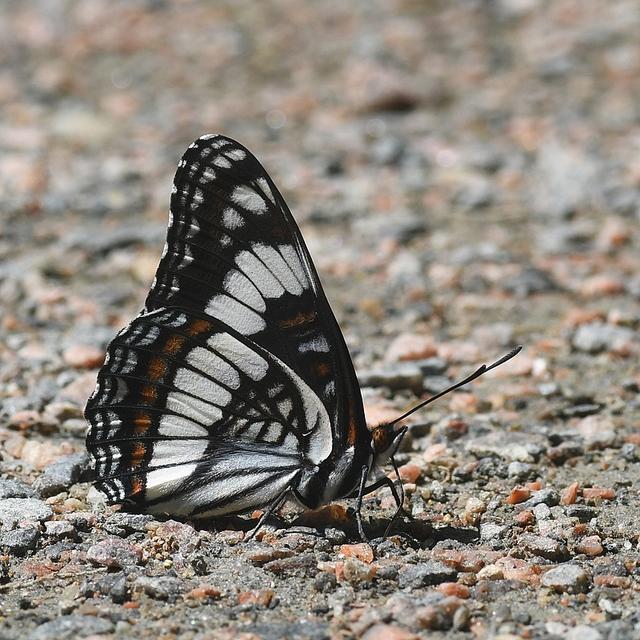Weidemeyer's Admiral
Limenitis weidemeyerii W.H. Edwards, 1861
Family: Nymphalidae
Subfamily: Limenitidinae
Identification: Upperside is black with a white median band on both wings; submarginal areas of hindwing are black. Underside is brown with white markings repeated; base of hindwing is gray-white with dark crosslines; marginal spots on hindwing are gray-white.
Wing Span: 2 1/4 - 3 3/4 inches (5.7 - 9.5 cm).
Life History: Males perch on trees and shrubs to watch for receptive females, rarely patrolling. Females lay eggs singly on the tips of host plant leaves; caterpillars eat leaves. Third-stage caterpillars hibernate in shelters made of leaves.
Flight: One or two broods from June-September.
Caterpillar Hosts: Aspen and cottonwood (Populus), willows (Salix), ocean spray (Holodiscus), and shadbush (Amelanchier).
Adult Food: Tree sap, carrion, flower nectar.
Habitat: Deciduous forest, streamsides in coniferous forests, aspen groves, small towns, suburbs.
Range: Southern Alberta south to Nebraska and east-central California, southeastern Arizona and southern New Mexico.
Conservation: Not usually required.
NCGR: G5 - Demonstrably secure globally, though it may be quite rare in parts of its range, especially at the periphery.
Management Needs: None reported.
Please donate!
We depend on donations to keep Butterflies and Moths of North America freely available. We want to express our gratitude to all who showed their support by making a contribution this year. You can donate to support this project at any time.
Advertise with us!
Do you have a product or service that you think would interest BAMONA users? If you would like to advertise on this website, contact us by email, or use the contact form and select the "Advertising" category.
Verified Sightings
Displaying 1 - 24 of 549 verified sightings

Observation date: Jul 29, 2020
Submitted by: blgreco
Region: Mineral County, Colorado, United States
Verified by: mikefisher
Verified date: Oct 26, 2025

Observation date: Aug 23, 2025
Submitted by: NikkiM
Region: Carbon County, Montana, United States
Verified by: J_Martineau
Verified date: Sep 04, 2025

Observation date: Jun 24, 2025
Submitted by: deftones
Region: El Paso County, Colorado, United States
Verified by: mikefisher
Verified date: Aug 24, 2025

Observation date: Aug 09, 1991
Submitted by: papilio1
Region: Bear Lake County, Idaho, United States
Verified by: stevekohler
Verified date: Aug 06, 2025

Observation date: Jul 27, 2025
Submitted by: jvkopple2
Region: Boulder County, Colorado, United States
Verified by: mikefisher
Verified date: Aug 03, 2025

Observation date: Jul 20, 2025
Submitted by: NikkiM
Region: Carbon County, Montana, United States
Verified by: J_Martineau
Verified date: Jul 27, 2025

Observation date: Jul 10, 2025
Submitted by: Cascade Colors
Region: Grand County, Colorado, United States
Verified by: mikefisher
Verified date: Jul 13, 2025

Observation date: Jun 27, 1986
Submitted by: papilio1
Region: Mono County, California, United States
Verified by: Ken Davenport
Verified date: Jul 06, 2025

Observation date: Jul 02, 2025
Submitted by: blgreco
Region: Archuleta County, Colorado, United States
Verified by: mikefisher
Verified date: Jul 06, 2025

Observation date: Jun 25, 2025
Submitted by: Duck1crazy
Region: Wasatch County, Utah, United States
Verified by: James Steen
Verified date: Jun 25, 2025

Observation date: Jun 20, 2025
Submitted by: topper72
Region: Los Alamos County, New Mexico, United States
Verified by: stevecary
Verified date: Jun 22, 2025

Observation date: Jun 19, 2025
Submitted by: Gordon Berman
Region: Otero County, New Mexico, United States
Verified by: stevecary
Verified date: Jun 20, 2025

Observation date: Jun 14, 2025
Submitted by: Dogoszhi
Region: Sandoval County, New Mexico, United States
Verified by: stevecary
Verified date: Jun 17, 2025

Observation date: Jun 13, 2025
Submitted by: Heatherbellca
Region: Jefferson County, Colorado, United States
Verified by: mikefisher
Verified date: Jun 15, 2025

Observation date: Jun 07, 2025
Submitted by: ezeemonee
Region: El Paso County, Colorado, United States
Verified by: mikefisher
Verified date: Jun 15, 2025

Observation date: Jun 21, 2024
Submitted by: Robert Gorman
Region: Greenlee County, Arizona, United States
Verified by: John Saba
Verified date: Dec 09, 2024

Observation date: Jun 15, 2024
Submitted by: ncrosbyrd
Region: Apache County, Arizona, United States
Verified by: John Saba
Verified date: Oct 09, 2024

Observation date: Aug 23, 2024
Submitted by: bonfrey
Region: San Miguel County, New Mexico, United States
Verified by: stevecary
Verified date: Sep 29, 2024

Observation date: Aug 05, 2024
Submitted by: ncrosbyrd
Region: Douglas County, Colorado, United States
Verified by: mikefisher
Verified date: Sep 15, 2024

Observation date: Aug 12, 2024
Submitted by: Cascade Colors
Region: Grand County, Colorado, United States
Verified by: mikefisher
Verified date: Sep 15, 2024

Observation date: Jul 20, 2024
Submitted by: bonfrey
Region: Sandoval County, New Mexico, United States
Verified by: stevecary
Verified date: Sep 01, 2024

Observation date: Aug 02, 2024
Submitted by: ddroberts
Region: Sevier County, Utah, United States
Verified by: James Steen
Verified date: Aug 09, 2024

Observation date: Jul 06, 2024
Submitted by: dvollmar
Region: Custer County, South Dakota, United States
Verified by: J_Martineau
Verified date: Aug 08, 2024

Observation date: Jul 26, 2024
Submitted by: NikkiM
Region: Carbon County, Montana, United States
Verified by: J_Martineau
Verified date: Aug 07, 2024
- 1 of 23
- next ›








